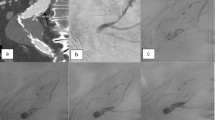Abstract
Aim
To evaluate safety, technical and clinical success of embolization of type Ia endoleak (T1a EL) using ethylene–vinyl alcohol copolymer as embolic agent alone or in combination with other materials.
Materials and methods
Five patients presented T1a EL after endovascular repair of aortic aneurysms (EVAR) with radiological evidence of expanding sac size; in particular, three had contained rupture. In one patient, proximal cuff insertion was previously performed, in three patients proximal cuff was urgently inserted but T1a EL persisted; one patient, previously treated with Ovation Abdominal Stent Graft System, was directly proposed for endovascular treatment. In all cases, endovascular embolization was successfully performed and the transfemoral approach was always chosen; in one case it failed and translumbar approach by direct puncture of the sac was required. Used embolization agents were glue, ethylene–vinyl alcohol copolymer (Onyx) and coils in three cases, n-butyl cyanoacrylate and Onyx in one case, Onyx and coils in the last case.
Results
Technical success rate was 100% as well as clinical success. No major or minor complication, including non-target embolization, was registered. Clinical success was 100% until today and the sac diameter remained stable in four patients and decreased in one.
Conclusions
Onyx may be considered a suitable embolic agent in the treatment of patients with type Ia endoleaks after EVAR, after failure of conventional treatments such as prolonged balloon inflation of the aortic neck or deployment of large bare stent.


Similar content being viewed by others
References
Walker TG, Kalva SP, Yeddula K, Wicky S, Kundu S, Drescher P, d’Othee BJ, Rose SC, Cardella JF (2010) Clinical practice guidelines for endovascular abdominal aortic aneurysm repair: written by the Standards of Practice Committee for the Society of Interventional Radiology and endorsed by the Cardiovascular and Interventional Radiological Society of Europe and the Canadian Interventional Radiology Association. J Vasc Interv Radiol 21(11):1632–1655
Mehta M, Sternbach Y, Taggert JB, Kreienberg PB, Roddy SP, Paty PS, Ozsvath KJ, Darling RC (2010) Long-term outcomes of secondary procedures after endovascular aneurysm repair. J Vasc Surg 52:1442–1449
Baum R, Stavropoulos W, Fairman RM, Carpenter JP (2003) Endoleaks after endovascular repair of abdominal aortic aneurysms. J Vasc Interv Radiol 14:1111–1117
Georgakarakos E, Argyriou C, Schoretsanitis N, Ioannou CV, Kontopodis N, Morgan R, Tsetis D (2014) Geometrical factors influencing the hemodynamic behavior of the AAA stent grafts: essentials for the clinician. Cardiovasc Interv Radiol 37(6):1420–1429
Venermo MA, Arko FR 3rd, Salenius JP, Saarinen JP, Zvaigzne A, Zarins CK (2011) EVAR may reduce the risk of aneurysm rupture despite persisting type Ia endoleaks. J Endovasc Ther 18:676–682
Khaja MS, Park AW, Swee W, Evans AJ, Angle JF, Turba UC, Sabri SS, Matsumoto AH (2014) Treatment of type II endoleak using Onyx with long-term imaging follow-up. Cardiovasc Interv Radiol 37(3):613–622
Grisafi JL, Boiteau G, Detschelt E, Potts J, Kiproff P, Muluk SC (2010) Endoluminal treatment of type IA endoleak with Onyx. J Vasc Surg 52(5):1346–1349
Maldonado TS, Rosen RJ, Rockman CB, Adelman MA, Bajakian D, Jacobowitz GR, Riles TS, Lamparello PJ (2003) Initial successful management of type I endoleak after endovascular aortic aneurysm repair with n-butyl cyanoacrylate adhesive. J Vasc Surg 38(4):664–670
Chun JY, Morgan R (2013) Transcatheter embolisation of type 1 endoleaks after endovascular aortic aneurysm repair with Onyx: when no other treatment option is feasible. Eur J Vasc Endovasc Surg 45(2):141–144
Rand T, Uberoi R, Cil B, Munneke G, Tsetis D (2013) Quality improvement guidelines for imaging detection and treatment of endoleaks following endovascular aneurysm repair (EVAR). Cardiovasc Intervent Radiol 36:35–45
Cao P, De Rango P, Verzini F, Parlani G (2010) Endoleak after endovascular aortic repair: classification, diagnosis and management following endovascular thoracic and abdominal aortic repair. J Cardiovasc Surg 51:53–69
Choi SY, Won JY, do Lee Y, Choi D, Shim WH, Lee KH (2010) Percutaneous transabdominal approach for the treatment of endoleaks after endovascular repair of infrarenal abdominal aortic aneurysm. Korean J Radiol 11:107–114
Eberhardt KM, Sadeghi-Azandaryani M, Worlicek S, Koeppel T, Reiser MF, Treitl M (2014) Treatment of type I endoleaks using transcatheter embolization with onyx. J Endovasc Ther 21(1):162–171
Henrikson O, Roos H, Falkenberg M (2011) Ethylene vinyl alcohol copolymer (Onyx) to seal type 1 endoleak. A new technique. Vascular 19(2):77e81
Guimaraes M, Wooster M (2011) Onyx (ethylene-vinyl alcohol copolymer) in peripheral applications. Semin Interv Radiol 28:350–356
Ierardi AM, Micieli C, Angileri SA, Rivolta N, Piffaretti G, Tonolini M, Fontana F, Miele V, Brunese L, Carrafiello G (2017) Ethylene-vinyl alcohol copolymer as embolic agent for treatment of type II endoleak: our experience. Radiol Med 122(2):154–159
Author information
Authors and Affiliations
Corresponding author
Ethics declarations
Conflict of interest
All authors declare to have no conflict of interest.
Ethical approval
All procedures performed in studies involving human participants were in accordance with the ethical standards of the institutional and/or national research committee and with the 1964 Helsinki Declaration and its later amendments or comparable ethical standards.
Informed consent
Additional informed consent was obtained from all individual participants for whom identifying information is included in this article.
Rights and permissions
About this article
Cite this article
Ierardi, A.M., Franchin, M., Fontana, F. et al. The role of ethylene–vinyl alcohol copolymer in association with other embolic agents for the percutaneous and endovascular treatment of type Ia endoleak. Radiol med 123, 638–642 (2018). https://doi.org/10.1007/s11547-018-0885-4
Received:
Accepted:
Published:
Issue Date:
DOI: https://doi.org/10.1007/s11547-018-0885-4




